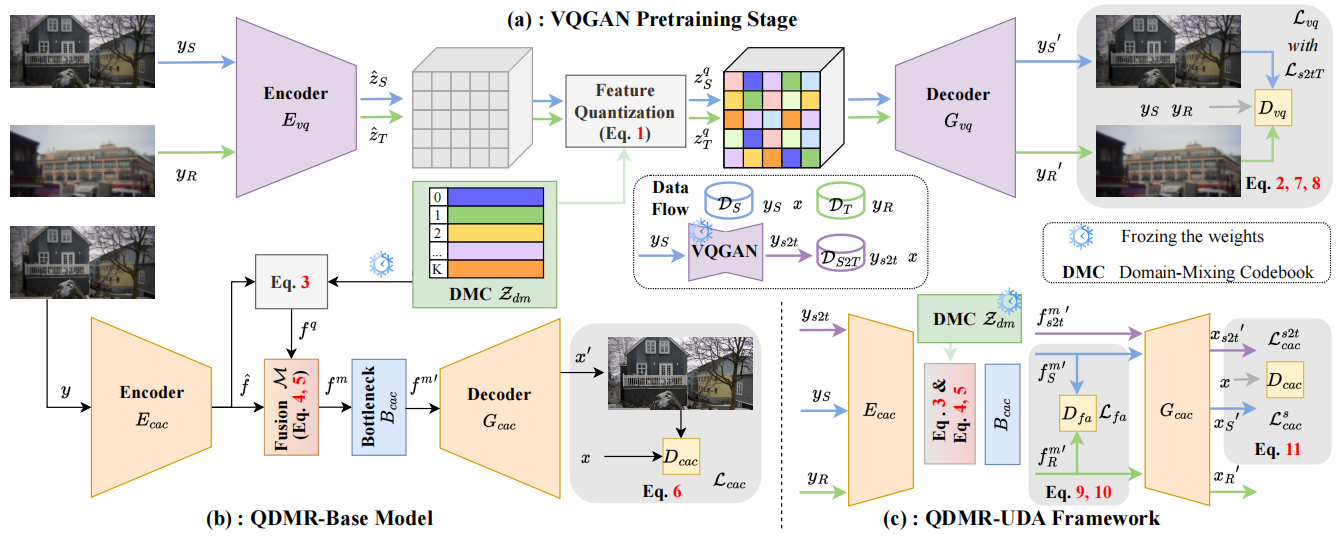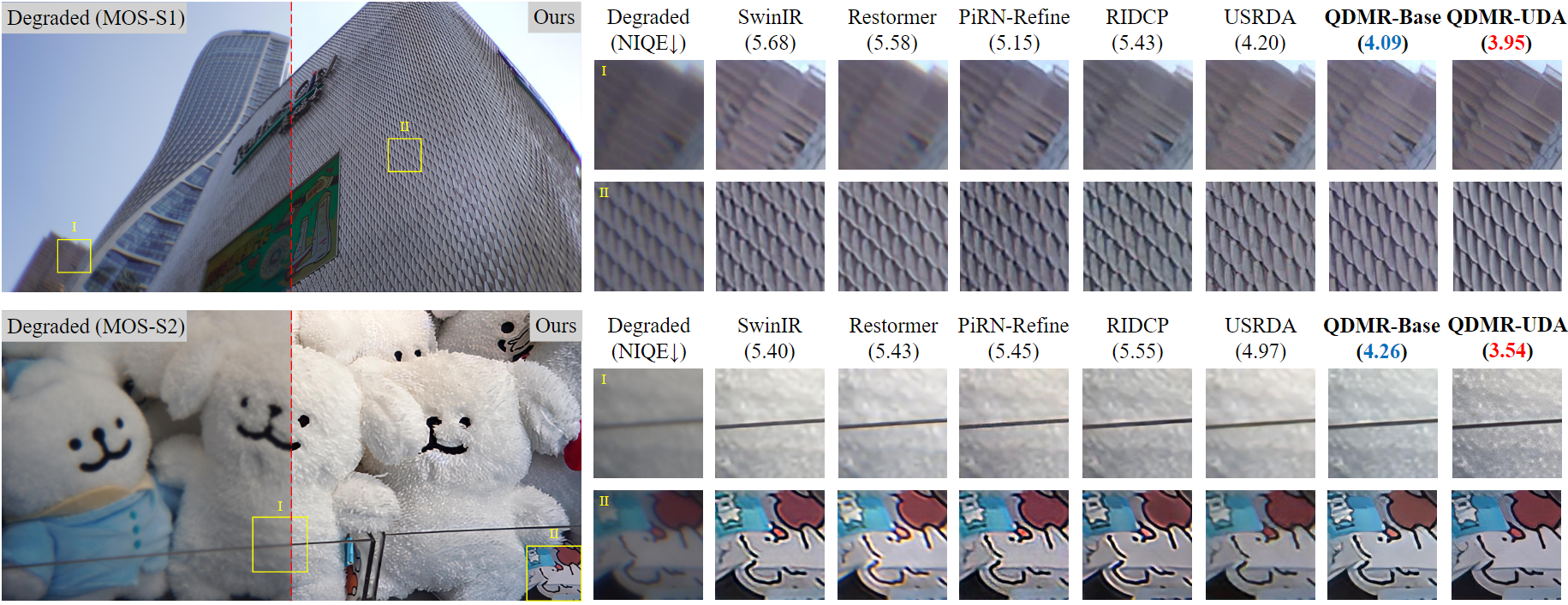Real-world Computational Aberration Correction via Quantized Domain-Mixing Representation
Qi Jiang, Zhonghua Yi, Shaohua Gao, Yao Gao et al.
Relying on paired synthetic data, existing learning-based Computational Aberration Correction (CAC) methods are confronted with the intricate and multifaceted synthetic-to-real domain gap, which leads to suboptimal performance in real-world applications. In this paper, in contrast to improving the simulation pipeline, we deliver a novel insight into real-world CAC from the perspective of Unsupervised Domain Adaptation (UDA). By incorporating readily accessible unpaired real-world data into training, we formalize the Domain Adaptive CAC (DACAC) task, and then introduce a comprehensive Real-world aberrated images (Realab) dataset to benchmark it. The setup task presents a formidable challenge due to the intricacy of understanding the target aberration domain. To this intent, we propose a novel Quantized Domain-Mixing Representation (QDMR) framework as a potent solution to the issue. QDMR adapts the CAC model to the target domain from three key aspects: (1) reconstructing aberrated images of both domains by a VQGAN to learn a Domain-Mixing Codebook (DMC) which characterizes the degradation-aware priors; (2) modulating the deep features in CAC model with DMC to transfer the target domain knowledge; and (3) leveraging the trained VQGAN to generate pseudo target aberrated images from the source ones for convincing target domain supervision. Extensive experiments on both synthetic and real-world benchmarks reveal that the models with QDMR consistently surpass the competitive methods in mitigating the synthetic-to-real gap, which produces visually pleasant real-world CAC results with fewer artifacts.
Overall illustration of our work:
Overall illustration of the task:
We solve a significant issue of synthetic-to-real gap in real-world computational aberration correction, from a novel perspective of unsupervised domain adaptation, where the unpaired (unlabeled) real-world aberrated images are incorporated into the training process. For more details, please refer to our paper.
To obtain the Realab dataset, please follow this instruction.
Overall illustration of QDMR:
QDMR adapts the CAC model to the target domain from three key aspects: (1) reconstructing aberrated images of both domains by a VQGAN to learn a Domain-Mixing Codebook (DMC) which characterizes the degradation-aware priors; (2) modulating the deep features in CAC model with DMC to transfer the target domain knowledge; and (3) leveraging the trained VQGAN to generate pseudo target aberrated images from the source ones for convincing target domain supervision.
QDMR can effectively mitigate the synthetic-to-real gap issue in real-world CAC, producing realistic aberration-free images without artifacts.
More details can be found in our paper.
The implementation of our work is based on BasicSR, which is an open source toolbox for image/video restoration tasks.
- Clone this repo or download the project.
git clone https://github.com/zju-jiangqi/QDMR
cd QDMR- Requirements.
python 3.10
pytorch 1.12.1
cuda 11.3conda create -n QDMR python=3.10
conda activate QDMR
pip install torch==1.12.1+cu113 torchvision==0.13.1+cu113 torchaudio==0.12.1 --extra-index-url https://download.pytorch.org/whl/cu113
pip install -r requirements.txt
python setup.py developFirst, train a VQGAN to learn QDMR and obtain the s2tT model.
Check and adapt the yml file according to the path of datasets and pretrained models options/train/Syn2RealSim/pretrain_VQGAN.yml for Real-Sim (or options/train/Syn2RealSnap/pretrain_VQGAN.yml for Real-Snap), then
-VQGAN pretrain
PYTHONPATH="./:${PYTHONPATH}" CUDA_VISIBLE_DEVICES=0 python basicsr/train.py -opt options/train/Syn2RealSim/pretrain_VQGAN.yml --auto_resumeor
PYTHONPATH="./:${PYTHONPATH}" CUDA_VISIBLE_DEVICES=0 python basicsr/train.py -opt options/train/Syn2RealSnap/pretrain_VQGAN.yml --auto_resumeTraining files (logs, models, training states and visualizations) will be saved in the directory ./experiments/{name}
Then, use the pre-trained DMC and VQGAN to train QDMR-Base or QDMR-UDA.
Our pre-trained weights are also available.
- Download the pre-trained DMC and trained models from our Huggingface or Baidu Disk to './pretrain'.
-QDMR-Base:
PYTHONPATH="./:${PYTHONPATH}" CUDA_VISIBLE_DEVICES=0 python basicsr/train_uda.py -opt options/train/Syn2RealSim/train_QDMR_Base.yml --auto_resumeor
PYTHONPATH="./:${PYTHONPATH}" CUDA_VISIBLE_DEVICES=0 python basicsr/train_uda.py -opt options/train/Syn2RealSnap/train_QDMR_Base.yml --auto_resume-QDMR-UDA (2 GPUs):
PYTHONPATH="./:${PYTHONPATH}" CUDA_VISIBLE_DEVICES=0,1 python basicsr/train_uda.py -opt options/train/Syn2RealSim/train_QDMR_UDA.yml --auto_resumeor
PYTHONPATH="./:${PYTHONPATH}" CUDA_VISIBLE_DEVICES=0,1 python basicsr/train_uda.py -opt options/train/Syn2RealSnap/train_QDMR_UDA.yml --auto_rThe referenced metrics and qualitative results can be calculated on Real-Sim:
- Real-Sim:
PYTHONPATH="./:${PYTHONPATH}" CUDA_VISIBLE_DEVICES=0 python basicsr/test.py -opt options/test/RealSim/test_QDMR_Base.yml
PYTHONPATH="./:${PYTHONPATH}" CUDA_VISIBLE_DEVICES=0 python basicsr/test.py -opt options/test/RealSim/test_QDMR_UDA.ymlThe non-referenced metric and qualitative results can be calculated on Real-Snap:
- Real-Snap:
PYTHONPATH="./:${PYTHONPATH}" CUDA_VISIBLE_DEVICES=0 python basicsr/test.py -opt options/test/RealSnap/test_QDMR_Base.yml
PYTHONPATH="./:${PYTHONPATH}" CUDA_VISIBLE_DEVICES=0 python basicsr/test.py -opt options/test/RealSnap/test_QDMR_UDA.ymlEvaluating files (logs and visualizations) will be saved in the directory ./results/{name}
We only offer an example of the experiments on MOS-S1, where those on MOS-S2 can be implemented by changing the paths of datasets and pretrained priors.
This project is released under the Apache 2.0 license.
@misc{jiang2024realworld,
title={Real-World Computational Aberration Correction via Quantized Domain-Mixing Representation},
author={Qi Jiang and Zhonghua Yi and Shaohua Gao and Yao Gao and Xiaolong Qian and Hao Shi and Lei Sun and Zhijie Xu and Kailun Yang and Kaiwei Wang},
year={2024},
eprint={2403.10012},
archivePrefix={arXiv},
primaryClass={cs.CV}
}
This project is built based on the excellent BasicSR project.
Should you have any questions, please contact me via qijiang@zju.edu.cn.




